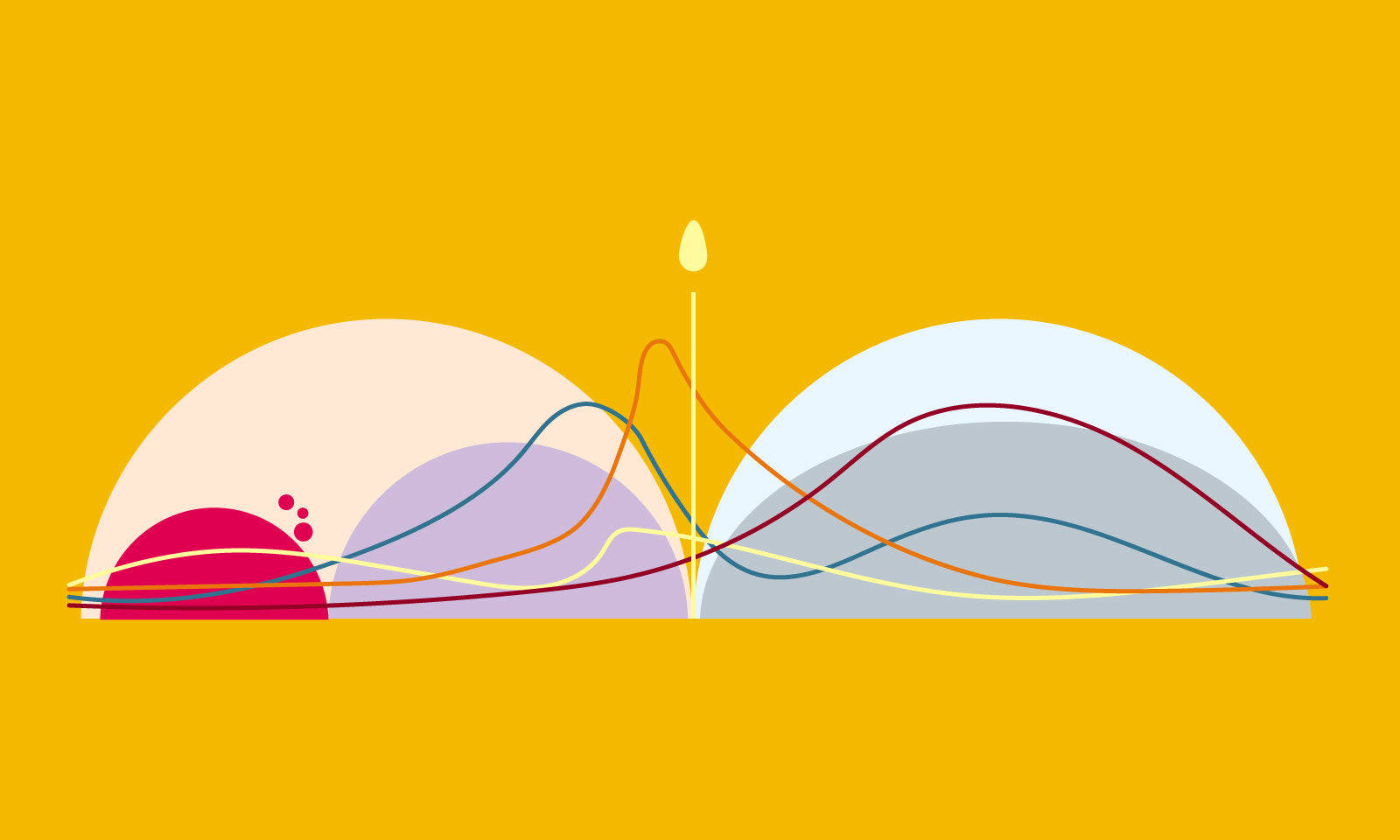What Menstrual Cycle Hormones Do for Your Body & Your Mood

Everyone assumes that the menstrual cycle is the week a person is on their period, but it’s actually a bit more complicated than that. In reality, the menstrual cycle is a whole monthly set of phases and stages a person will go through from puberty to menopause, and it’s all driven by menstrual cycle hormones.
Here, we’ve set out a little more information on the hormones involved in your menstrual cycle, how they help to control it, and how, once released, they might even play a big role in those awful mood swings and bloated moments we all get. It might even help you understand what’s going on in your body on those days when you’re feeling particularly sensitive!
Your hormones during the menstrual cycle phases
Hormone levels don’t stay stock-still. They’re busy shifting all the time and there will be times when you have higher levels of certain hormones than others, especially as you move through the different phases of the menstrual cycle.
Experts usually divide the menstrual cycle into four phases. The first is the bleeding we all experience once a month that’s commonly become known as a period. It’s also called the menstrual phase. The other phases are:
- The follicular phase
- The ovulation phase
- The luteal phase
Hormones and the menstrual phase
This phase always starts when an egg from your previous ovulation hasn’t been fertilised. Because you’re not pregnant, your body’s levels of oestrogen and progesterone will drop.
The thickened lining of your uterus, which would normally go towards supporting a pregnancy, will start shedding through your vagina during this phase. This, combined with a mix of blood and mucus, is what people usually think of when they hear the term “period blood”.
On average, the menstrual phase should last for between 2 and 7 days.
Hormones and the follicular phase
This phase has a bit of overlap with the menstrual phase, because it starts on the first day of your period. However, it continues a lot longer than the first phase, going right up until the moment you start ovulating.
The phase starts when the hypothalamus (a small but really important part of the centre of your brain) sends a signal to your pituitary gland (the master gland that controls a lot of other hormone glands) to release follicle-stimulating hormone (FSH). This hormone stimulates the growth of between 5 and 20 sacs, called “follicles”, which are produced by your ovaries.
Each of these ovarian follicles contains an immature egg. Only the healthiest egg (or eggs, on those rare occasions) will eventually mature, becoming what’s called the “dominant follicle”. The rest will be absorbed back into your body.
A maturing follicle will cause a boost in your oestrogen hormone levels, which causes the lining of your uterus to thicken. This is the nutrient-rich environment an embryo would usually need to start growing.
Generally, a follicular phase should last for around 16 days, but can be as short as 11 days and as long as 27 days. It all depends on your cycle, and you know this better than anybody!
Hormones and the ovulation phase
As the oestrogen levels in your body start to rise, they’ll trigger your pituitary gland to start releasing the luteinising hormone (LH). This is how ovulation starts.
In this phase, your body will release a mature egg from one of your ovaries. The egg will then travel down the fallopian tube towards the uterus and be fertilised if it meets a sperm cell.
This is the only time out of the four phases when you can get pregnant, and you should be able to tell if you’re ovulating by checking:
- If you’ve had a slight rise in basal body temperature (your lowest body temperature while resting, not exercising)
- If you’ve got thicker vaginal discharge (it should have the texture of egg whites)
If your normal cycle lasts for around 28 days, ovulation should happen on or around day 14 (so right in the middle of the cycle). The stage will last for 24 hours and if an egg isn’t fertilised in this time it will dissolve.
We should also say that this isn’t the only time you can get pregnant in your cycle, though! As sperm can live for up to 5 days, it’s possible for them to survive in your body until the egg is released.
Hormones and the luteal phase
After the follicle has released its egg, it changes and becomes the corpus luteum. This is a structure that’s designed to release hormones, specifically progesterone and some oestrogen. Keeping these hormone levels high helps to keep your uterus lining thick, in case it needs to be ready for a fertilised egg.
If you do get pregnant during a cycle, your body will then start producing the hormone human chorionic gonadotropin (hCG). This is the hormone that’s picked up by pregnancy tests when you take them, and works to keep the corpus luteum maintained while also keeping the uterine lining thick.
If you don’t get pregnant during a cycle, the corpus luteum will shrink and be reabsorbed into your body. This also causes a drop in your oestrogen and progesterone, which then triggers your period and the shedding of your uterine lining.
You’re also likely to experience symptoms of premenstrual syndrome (PMS) during this phase, including:
- Bloating
- Breast tenderness, pain, or swelling
- Changes in sex drive
- Food cravings (especially for junk food)
- Headaches
- Mood changes
- Trouble sleeping
- Weight gain
On average, the luteal phase should last around 14 days, but it can be anywhere in length from 11 to 17 days.
Menstrual cycle hormones and your mood
Around a week or so before your period, you may start experiencing the physical and emotional symptoms that go to make up PMS. It’s not really known why we do, but professionals think it’s likely connected to the hormones involved in your menstrual cycle, especially the fluctuating levels of oestrogen and progesterone.
Changes in these hormones’ levels can lead to changes in serotonin levels ‒ the hormone that stabilises mood, feelings of well-being, and happiness. It’s also the hormone that controls our sleep cycles and appetites.
Low levels of serotonin have been linked in the past to feelings of sadness, irritability, trouble sleeping, and unusual food cravings. All of these are also famously associated with PMS, so you can start to see where your feelings, needs, and wants keep coming from in the run-up to your days!
It’s also possible to feel a little bit moodier before your period because of two related conditions:
- Premenstrual dysphoric disorder (PMDD), which is like PMS but has more severe symptoms. This can include intense mood swings that interfere with everyday life
- Premenstrual exacerbation, which is when the symptoms of a preexisting condition (like anxiety, depression, or bipolar disorder) become worse in the weeks or days that lead up to your period
Keeping in control of your moods and symptoms
These mood changes might happen because of the hormones involved in the menstrual cycle, but that doesn’t mean you can’t manage them. There are a few things you can do to help keep in control of your moods and some of your other symptoms:
Track your cycle and look for patterns
By keeping an eye on your menstrual cycle and jotting down the emotions you’re experiencing and when, you can confirm if any particularly intense moods you’re feeling are linked to your phases. Knowing this is fantastic validation, but it’s also great to keep things in perspective if you ever find yourself upset or annoyed over something really small.
Finding patterns over your last few cycles and having a clear, detailed record is also handy if you need to speak to your doctor. It’ll help you to feel more confident about bringing the subject up if you think there’s a problem, and it’ll help your doctor to get a better understanding of what might be going on.
The easiest way to keep track of your symptoms is to install an app on your phone where you can write in your symptoms, but you can also print out or make your own chart, complete with all the days of the month and a list of symptoms you’re likely to experience. You can then check off these symptoms on the days you’ve experienced them to see if you notice certain patterns and specific symptoms happening regularly.
Going on hormonal birth control
Hormonal birth control is often just what you’ll need to take care of emotional symptoms. It can also help with physical symptoms like bloating or breast tenderness.
However, it’s also possible that hormonal birth control will make emotional symptoms worse, so you might have to try out different types to see which one suits you best.
Natural foods and remedies
Certain vitamins and supplements have been found to help take the edge off mood swings related to PMS. Calcium, for example, was found in a clinical trial to help with the sadness, anxiety, and irritability that are all often related to menstrual symptoms. It can be taken in tablet form, but if you’d prefer to make something tasty to help tackle your cravings at the same time, you can also find calcium in:
- Leafy green vegetables
- Cereal
- Orange juice
- Nuts and seeds
There are a lot of foods out there that could help you manage your period symptoms, including bloating and cramping. If you’d like some friendly advice and a few ideas on where to start with meals and snacks to get you through your more delicate days, take a look at our page on foods that help with period cramps.
Changing your lifestyle
Making changes to few different lifestyle factors has been linked to helping PMS symptoms in the past, including:
- Getting at least 30 minutes of exercise every day, which has been said to help with more intense feelings of sadness and irritability
- Getting around 7 or 8 hours of sleep a night, especially in the two weeks leading up to your period
- Resisting cravings for junk food. This doesn’t mean cutting it completely, though; it means balancing it out with healthier foods to help keep you full and to avoid drops in your blood sugar levels
- Managing stress with breathing exercises, meditation, or yoga
Taking medication
If other treatment options aren’t helping, you may want to talk to your doctor about getting medication prescribed to help with your moods during your period. They’ll be able to offer the advice and support you’re looking for, while finding the best one for your symptoms.
Helping you prepare for the start of your new cycle
We totally get that you want to be ready for your period, and every other part of your cycle, whenever it comes around again. We might not be able to help with hormonal changes, but we can supply super-soft, ultra-absorbent period pants to support you and get you through your phases with that little bit of extra flair!
Our leak-proof, moisture-wicking collections are all designed to hold between half and 5 whole tampons’ worth of flow (depending on the style), so you’ll have all the coverage you need to stay fresh and secure while feeling fabulous as soon as you’ve chosen. They’re all totally discreet, too ‒ they look and feel just like regular underwear!
No matter what kind of cycle you’re having, our undies can be there to help. Pick out your perfect pairs today and try them on for size! We’ve even got a 60-day money-back guarantee if you’re not completely satisfied.
- Tags: Periods



